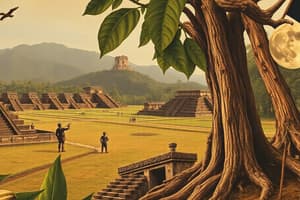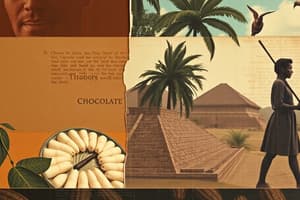Podcast
Questions and Answers
What was the significance of cacao in Mesoamerican cultures?
What was the significance of cacao in Mesoamerican cultures?
Cacao was believed to be a heavenly food gifted to humans by a feathered serpent god and was used as currency, in royal feasts, as a reward for soldiers, and in rituals.
What was the original use of cacao beans in Mesoamerica?
What was the original use of cacao beans in Mesoamerica?
The beans were ground and mixed with cornmeal and chili peppers to create a bitter, invigorating drink.
Who introduced the Spanish to chocolate, and when?
Who introduced the Spanish to chocolate, and when?
Hernán Cortés introduced the Spanish to chocolate in 1519, at the court of Montezuma at Tenochtitlan.
Why was chocolate initially used as a medicine in Europe?
Why was chocolate initially used as a medicine in Europe?
How did the production of chocolate affect the Caribbean and African islands?
How did the production of chocolate affect the Caribbean and African islands?
What invention by Conrad van Houten revolutionized the world of chocolate in 1828?
What invention by Conrad van Houten revolutionized the world of chocolate in 1828?
How did the Spanish colonizers initially perceive chocolate?
How did the Spanish colonizers initially perceive chocolate?
What was the status symbol associated with chocolate in 16th-century Europe?
What was the status symbol associated with chocolate in 16th-century Europe?
What innovation allowed for the creation of the solid chocolate we know today?
What innovation allowed for the creation of the solid chocolate we know today?
Who added powdered milk to chocolate, creating milk chocolate?
Who added powdered milk to chocolate, creating milk chocolate?
What was a major consequence of the growing demand for chocolate in the 20th century?
What was a major consequence of the growing demand for chocolate in the 20th century?
What is a pervasive problem in West African cocoa plantations, despite efforts to combat it?
What is a pervasive problem in West African cocoa plantations, despite efforts to combat it?
How has chocolate become embedded in modern culture?
How has chocolate become embedded in modern culture?
What is the significance of understanding chocolate's history and production?
What is the significance of understanding chocolate's history and production?
How has the production of chocolate shifted since the colonial era?
How has the production of chocolate shifted since the colonial era?
What is the irony of chocolate's cultural significance?
What is the irony of chocolate's cultural significance?
Study Notes
History of Chocolate
- People in Mesoamerica prepared cacao beans as early as 1900 BCE, grinding and mixing them with cornmeal and chili peppers to create a bitter, invigorating drink.
Mesoamerican Significance
- Mesoamericans believed cacao was a heavenly food gifted by a feathered serpent god (Kukulkan to the Maya, Quetzalcoatl to the Aztecs).
- Aztecs used cacao beans as currency, drank chocolate at royal feasts, gave it to soldiers as a reward, and used it in rituals.
European Encounter
- In 1519, Hernán Cortés encountered chocolate at the court of Montezuma, where 50 jugs were poured into golden cups.
- Missionaries' accounts of native customs led to chocolate being seen as an aphrodisiac.
Development of Chocolate
- Sweetening chocolate with honey, sugar, or vanilla made it a popular delicacy in the Spanish court.
- The invention of the cocoa press by Conrad van Houten in 1828 allowed for mass production by separating cocoa butter from cocoa powder.
- Daniel Peter added powdered milk to create milk chocolate.
Globalization of Chocolate
- Chocolate production shifted to West Africa, with Côte d'Ivoire providing two-fifths of the world's cocoa as of 2015.
- Many West African plantations use slave and child labor, with over two million children affected.
Modern Chocolate Industry
- Efforts have been made by major chocolate companies to reduce child and indentured labor practices, but the problem persists.
- Chocolate's colonial association with native cultures and advertising have created an aura of something sensual, decadent, and forbidden.
Studying That Suits You
Use AI to generate personalized quizzes and flashcards to suit your learning preferences.
Description
Explore the significance of cacao in Mesoamerican cultures, its original use, and its introduction to Europe. Learn about the impact of chocolate production on the Caribbean and African islands and the revolutionary invention that changed the chocolate industry.




